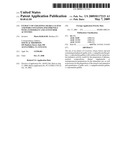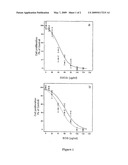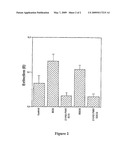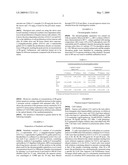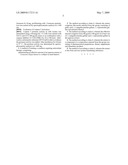Patent application title: EXTRACT OF CERATONIA SILIQUA LEAVES AND PODS CONTAINING POLYPHENOLS WITH ANTIOXIDANT AND ANTITUMOR ACTIVITIES
Inventors:
Mario Baraldi (Modena, IT)
IPC8 Class: AA61K3600FI
USPC Class:
424774
Class name: Drug, bio-affecting and body treating compositions plant material or plant extract of undetermined constitution as active ingredient (e.g., herbal remedy, herbal extract, powder, oil, etc.) containing or obtained from a leaf (aka folium or foliage)
Publication date: 2009-05-07
Patent application number: 20090117215
Ceratonia siliqua leaves and pod containing
polyphenols (gallic acid, (-)-epigallocatechin gallate, (-)-epicatechin
gallate) with oxidant activity and potential antitumor activity, useful
for the preparation of pharmaceutical compositions, dietary supplements
or extemporaneous preparations for the alimentary use, as well as
processes for the preparation of the extracts and separation and
quantitation of gallic acid, (-)-epigallocatechin gallate,
(-)-epicatechin gallate.Claims:
1. A method of treating a condition requiring antioxidant therapy,
comprising:administering an effective amount of an aqueous extract of
Ceratonia siliqua leaves to a subject in need thereof.
2. The method according to claim 1, wherein the extract comprises flavonoids selected from the group consisting of gallic acid, (-)-epigallocatechin gallate, (-)-epicatechin gallate and mixtures thereof.
3. The method according to claim 1, wherein the effective amount comprises from 40 μg/ml to 80 μg/ml of at least one of (-)-epigallocatechin gallate and (-)-epicatechin gallate in the aqueous extract.
4. The method according to claim 1, wherein the extract is a component of a composition selected from the group consisting of pharmaceutical preparations, dietary supplements and alimentary products.
5. The method of according to claim 1, wherein the extract is free from nervous system-stimulating substances.Description:
[0001]This application is a divisional application of Ser. No. 10/492,594,
filed Aug. 17, 2004, currently pending, which claims priority to
PCT/EP02/11356, filed Oct. 10, 2002, which claims priority to Italian
Application No. MI2001A002141, filed Oct. 17, 2001. The teachings of the
above applications are hereby incorporated by reference. Any disclaimer
that may have occurred during prosecution of the above referenced
applications is hereby expressly disclaimed.
[0002]The present invention relates to an extract of Ceratonia siliqua leaves and pod containing polyphenols (gallic acid, (-)-epigallocatechin gailate, (-)-epicatechin gallate) with antioxidant activity and potential antitumor activity, useful for the preparation of pharmaceutical compositions, dietary supplements or extemporaneous preparations for the alimentary use. Said extract is characterized by high content in polyphenols as well as absence of central nervous system-stimulating substances, such as caffeine and theophylline.
TECHNICAL BACKGROUND
[0003]According to numerous papers in literature, diet rich in fruit and vegetables apparently concurs in preventing tumors of the gastrointestinal tract [J. M. Pezzetto, Biochem. Pharmacol. 53:121-123, 1997]. Vegetables, in fact, contain a number of compounds with antioxidant and antitumor activities, inter alia, flavonoids and polyphenols, which are considered able to interfere with the hepatic microsomal system, preventing it from activating the cancerogenic substances found in food and environment.
[0004]Flavonoids are a heterogeneous group of vegetable polyphenols (more than 4000) sharing a benzopyrane structure. They constitute pigments (orange, red and blue colours) of various vegetable (flowers, fruit, leaves) and are important factors for the growth, development and protection of plants. The major flavonoids with antioxidant activity present in vegetables are: (+)-catechin, (-)-epicatechin, epigallocatechin and the corresponding gallic acid esters: (-)-epicatechin gallate and (-)-epigallocatechin gallate [Blot et al. Am. J. Cancer Prevention 62:1477-82, 1992].
[0005]A number of studies reported the antitumor activity of these compounds [Cao Y. and Cao R. Nature 398: 391, 1999], in particular of (-)- epigallocatechin gallate (EGCG). EGCG takes part in:
[0006]regulating the cellular cycle, in particular through dose-dependent inhibition of mitosis by blocking cells in the G0-G1 phase;
[0007]inducing apoptosis (programmed cell death) in various tumour cells, but not in normal cells. This process is important for maintaining cell growth and proliferation balances. Tumour cells growth is in fact due to escape from the normal control mechanisms, which also act through regulation of apoptosis;
[0008]inhibiting urokinase, a proteolytic enzyme which allows tumour cells to invade the adjacent cells and form metastasis;
[0009]inhibiting angiogenesis;
[0010]eliminating free radicals thanks to its high antioxidant power.
[0011]Among the commercially available vegetable products, green and black teas have antioxidant and antitumour activities, due to their high contents in flavonoids; however, not all individuals can tolerate them due to the presence of stimulant substances such as caffeine and theophylline. Vegetable products containing flavonoids but free from any stimulating substances, for use in the prevention and/or treatment of degenerative diseases and in particular of tumors [Fujiki H. et at. Nutrition Reviews 54: 67-70, 1996] would therefore be valuable.
[0012]The present invention relates to an extract, either dry or aqueous, which has high content in polyphenols while being free from stimulating substances, obtained from carob (an evergreen tree with wide leafage, belonging to the order Rosales, family Papillionacee, sub-family Cesalpinoidee, genus Ceratonia, species Ceratonia siliqua).
BRIEF DESCRIPTION OF THE DRAWINGS
[0013]The invention will be described in connection with the attached drawing, in which:
[0014]FIG. 1 is a plot of the dose-dependent activities of EGCG (a) and EGC (b) on the inhibition of cell proliferation in liver tumour cells; and
[0015]FIG. 2 is a graph of the activation of the protease activity exerted by ECG and EGCG.
DETAILED DISCLOSURE OF THE INVENTION
[0016]The present invention relates to the use of a dry or aqueous extract of Ceratonia siliqua (carob) leaves and pod, containing polyphenols, for the preparation of pharmaceutical compositions, dietary supplements or extemporaneous preparations for the alimentary use, having antioxidant activity and potential antitumor activity. The term "polyphenols" herein preferably means gallic acid, (-)-epigallocatechin gallate and (-)-epicatechin gallate.
[0017]The present invention further relates to the process for the preparation of said extract.
[0018]Carob pod leaves or meal infused in hot distilled water for 15 min, preferably in a ratio of 1 g of leaves or meal to 50-200 ml of water, most preferably 1 g of leaves or meal to 100 ml of water. The aqueous extract is then centrifuged and filtered. A second aqueous extract is optionally obtained by further infusing the centrifugation residue. The aqueous extract or the combined aqueous extracts are evaporated to obtain a dry extract which consists solely of water-soluble substances and can therefore be easily dissolved and is well-suited for the preparation of formulations such as sachets, syrups, capsules. This extract is free from central nervous system-stimulating substances: as a consequence, it is well tolerated and does not require costly decaffeinization or deteination processes.
[0019]According to a preferred embodiment of the invention, the extract is prepared by infusing 1 g of carob leaves or pod meal in 100 ml of hot distilled water for 15 min. The aqueous extract is then centrifuged at 13,000 rpm for 10 mm and filtered through PTFE 0.22 μm filters. A second aqueous extract is obtained repeating the procedure on the centrifugation residue.
[0020]Carob leaves and pod contain fair amounts of polyphenols, mainly catechins (gallic acid, (-) epicatechin gallate, (-) epigallocatechin gallate), which have been separated and purified by chromatography (HPLC). The obtained amounts are (Table n°1, example 2) 6.28 mg/g dry leaves for the leaves and 1.36 mg/g of meal for the pod meal, respectively.
[0021]Biological tests carried out using the above mentioned catechins evidenced a marked, dose-dependent reduction in the proliferation of hepatic tumour cells cultures. FIG. 1 shows the dose-dependent activities of EGCG (a) and EGC (b) on the inhibition of cell proliferation in liver tumour cells after 24 (white dots) and 48 hours (black dots) exposure. (-)-Epigallocatechin gallate (EGCG) and (-)-epicatechin gallate (ECG) inhibit the proliferation already at concentrations of 40 μg/ml, reaching the peak activity at concentrations of 80 μg/ml. Furthermore, said reduction turned out to be higher for 48 hours treatments compared with 24 hours treatments.
[0022]Moreover, catechins at concentrations of 80 μg/ml induce apoptosis causing a significant increase in the caspase 3 protease activity compared with untreated cells. FIG. 2 shows the activation of the protease activity exerted by ECG and EGCG alone and in combination with a caspase 3 specific inhibitor (Z-VAD-FMK) expressed as arbitrary units referred to the optical density of the usedinstrumentation.
[0023]The invention is illustrated in greater detail by the following examples.
EXAMPLE 1
Preparation of Standards and Samples
[0024]Standards consisted of a mixture of (+)-catechin (C), (-)-epicatechin (EC), (-)-epigallocatechin-3-gallate (EGCG), (-)-epicatechin-3-gallate (ECG), gallic acid (GAc), theophylline (T), caffeine (Ca), chlorogenic acid (CIAc), caffeic acid (Cac), catechol (Ct) and tea extracts, containing teaflavin, teaflavin-3-monogallate, teaflavin-3'-monoqallate and teaflavin-3,3'-digallate (with purity >80%) were prepared dissolving known amounts of all the analytes in the mobile phase used for the chromatographic separation so as to reach concentrations from 0.3 to 500 μg/ml. Samples were prepared by infusing 1 g of carob leaves or pod meal in 100 ml of hot distilled water for 15 min. Afterwards, the aqueous extract was centrifuged at 13,000 rpm for 10 min, then filtered through PTFE 0.22 μm filters. A second aqueous extract was obtained from the centrifugation residue.
EXAMPLE 2
Chromatographic Analysis
[0025]The chromatographic separation was carried out with an analytic Microsorb RP-C18 100 A column (250×4.6 mm), thermostatized at 40° C., using a gradient with starting composition: 68% water, 22% of 0.5% phosphoric acid, 4% acetonitrile and 6% methanol, linearly increasing the organic solvents with a flow of 1 ml/min. UV-Vis absorption spectra (λ=198-708 nm) were recorded continuously and the samples absorption peaks were identified by comparing retention times and UV-Vis spectra with those of the standard. The peak area at 205 nm was used to establish calibration curves.
TABLE-US-00001 TABLE I Catechins quantitation by chromatographic analysis CAROB LEAVES CAROB MEAL rng/g ± s.d.* mg/g ± s.d.* 1st infusion 2nd infusion Total 1st infusion 2nd infusion Total G Ac 3.34 ± 0.032 0.96 ± 0.020 4.30 0.87 ± 0.000 0.33 ± 0.007 1.20 EGC -- -- -- 0.05 ± 0.000 0.01 ± 0.001 0.06 C -- -- -- 0.01 ± 0.000 -- 0.01 EGCG 1.23 ± 0.409 0.28 ± 0.030 1.51 0.01 ± 0.000 -- 0.01 EC -- -- -- -- -- -- ECG 0.47 ± 0.095 -- -- 0.06 ± 0.000 0.02 ± 0.004 0.08 Total 5.04 ± 0.395 1.24 ± 0.049 6.28 1.00 ± 0.008 0.36 ± 0.002 1.36 *= Means and Standard Deviations for 3 determinations
EXAMPLE 3
Pharmacological Experimentation
[0026]Cell Cultures
[0027]Tumour cell cultures (T1) used in the tests derive from transgenic mice hepatocellular carcinoma, in which an over-expression of the c-myc and TGFα had been induced. Cells were kept in L-glutamine-free DMEM medium, HAM F 12 containing 1 mg/ml galactose, 18 mM HEPES, 5 mM Na piruvate, 30 mg/M1 proline, ITS 100×, 2 mM glutamine, 0.1% gentamicin (Sigma-Aldrich, Italy) and added with 10% FBS. Cell lines were cultured in polystyrene plates (Dasit, Italy).
[0028]Cell Proliferation Assay
[0029]T1 cells were plated in 96 wells-plates at a concentration of 10,000 cells/well and left to sediment for 4-5 hours. Cells were then incubated in EGCG or ECG at a concentration of 20, 40, 60, 80, 160 μg/ml for 24 and 48 hours. The substances were diluted in the culture medium starting from stock solutions (aqueous solution for EGCG and aqueous-ethanol solution (1:1) for ECG). Control cells were treated with solutions containing ethanol in amounts corresponding to that of the samples containing catechins. After 24 or 48 hours, the proliferation was calorimetrically measured using a specific kit (Cell Titer Aqueous Cell Proliferation Assay, Promega) which makes use of a calorimetric transformation reaction of colourless MTS (tetrazolium salt) into coloured formazan by living, proliferating cells. Formazan quantitation was carried out by spectrophotometric analysis at λ=490 nm.
[0030]Evaluation of Caspase 3 Activation
[0031]Caspase 3 protease activity in cells lysates was determined using a Promega kit. T1 Cells were treated with EGCG and ECG (80 μg/ml) alone or in combination with a caspase inhibitor (Z-VAD-FMK) for 24 or 48 hours. Afterwards a calorimetric substrate (DEVD-pNA) able to evidence the protease activity was added. After incubation for 4 hours at 37° C., the protease activity was determined by spectrophotometric analysis at λ=405 nm.
Claims:
1. A method of treating a condition requiring antioxidant therapy,
comprising:administering an effective amount of an aqueous extract of
Ceratonia siliqua leaves to a subject in need thereof.
2. The method according to claim 1, wherein the extract comprises flavonoids selected from the group consisting of gallic acid, (-)-epigallocatechin gallate, (-)-epicatechin gallate and mixtures thereof.
3. The method according to claim 1, wherein the effective amount comprises from 40 μg/ml to 80 μg/ml of at least one of (-)-epigallocatechin gallate and (-)-epicatechin gallate in the aqueous extract.
4. The method according to claim 1, wherein the extract is a component of a composition selected from the group consisting of pharmaceutical preparations, dietary supplements and alimentary products.
5. The method of according to claim 1, wherein the extract is free from nervous system-stimulating substances.
Description:
[0001]This application is a divisional application of Ser. No. 10/492,594,
filed Aug. 17, 2004, currently pending, which claims priority to
PCT/EP02/11356, filed Oct. 10, 2002, which claims priority to Italian
Application No. MI2001A002141, filed Oct. 17, 2001. The teachings of the
above applications are hereby incorporated by reference. Any disclaimer
that may have occurred during prosecution of the above referenced
applications is hereby expressly disclaimed.
[0002]The present invention relates to an extract of Ceratonia siliqua leaves and pod containing polyphenols (gallic acid, (-)-epigallocatechin gailate, (-)-epicatechin gallate) with antioxidant activity and potential antitumor activity, useful for the preparation of pharmaceutical compositions, dietary supplements or extemporaneous preparations for the alimentary use. Said extract is characterized by high content in polyphenols as well as absence of central nervous system-stimulating substances, such as caffeine and theophylline.
TECHNICAL BACKGROUND
[0003]According to numerous papers in literature, diet rich in fruit and vegetables apparently concurs in preventing tumors of the gastrointestinal tract [J. M. Pezzetto, Biochem. Pharmacol. 53:121-123, 1997]. Vegetables, in fact, contain a number of compounds with antioxidant and antitumor activities, inter alia, flavonoids and polyphenols, which are considered able to interfere with the hepatic microsomal system, preventing it from activating the cancerogenic substances found in food and environment.
[0004]Flavonoids are a heterogeneous group of vegetable polyphenols (more than 4000) sharing a benzopyrane structure. They constitute pigments (orange, red and blue colours) of various vegetable (flowers, fruit, leaves) and are important factors for the growth, development and protection of plants. The major flavonoids with antioxidant activity present in vegetables are: (+)-catechin, (-)-epicatechin, epigallocatechin and the corresponding gallic acid esters: (-)-epicatechin gallate and (-)-epigallocatechin gallate [Blot et al. Am. J. Cancer Prevention 62:1477-82, 1992].
[0005]A number of studies reported the antitumor activity of these compounds [Cao Y. and Cao R. Nature 398: 391, 1999], in particular of (-)- epigallocatechin gallate (EGCG). EGCG takes part in:
[0006]regulating the cellular cycle, in particular through dose-dependent inhibition of mitosis by blocking cells in the G0-G1 phase;
[0007]inducing apoptosis (programmed cell death) in various tumour cells, but not in normal cells. This process is important for maintaining cell growth and proliferation balances. Tumour cells growth is in fact due to escape from the normal control mechanisms, which also act through regulation of apoptosis;
[0008]inhibiting urokinase, a proteolytic enzyme which allows tumour cells to invade the adjacent cells and form metastasis;
[0009]inhibiting angiogenesis;
[0010]eliminating free radicals thanks to its high antioxidant power.
[0011]Among the commercially available vegetable products, green and black teas have antioxidant and antitumour activities, due to their high contents in flavonoids; however, not all individuals can tolerate them due to the presence of stimulant substances such as caffeine and theophylline. Vegetable products containing flavonoids but free from any stimulating substances, for use in the prevention and/or treatment of degenerative diseases and in particular of tumors [Fujiki H. et at. Nutrition Reviews 54: 67-70, 1996] would therefore be valuable.
[0012]The present invention relates to an extract, either dry or aqueous, which has high content in polyphenols while being free from stimulating substances, obtained from carob (an evergreen tree with wide leafage, belonging to the order Rosales, family Papillionacee, sub-family Cesalpinoidee, genus Ceratonia, species Ceratonia siliqua).
BRIEF DESCRIPTION OF THE DRAWINGS
[0013]The invention will be described in connection with the attached drawing, in which:
[0014]FIG. 1 is a plot of the dose-dependent activities of EGCG (a) and EGC (b) on the inhibition of cell proliferation in liver tumour cells; and
[0015]FIG. 2 is a graph of the activation of the protease activity exerted by ECG and EGCG.
DETAILED DISCLOSURE OF THE INVENTION
[0016]The present invention relates to the use of a dry or aqueous extract of Ceratonia siliqua (carob) leaves and pod, containing polyphenols, for the preparation of pharmaceutical compositions, dietary supplements or extemporaneous preparations for the alimentary use, having antioxidant activity and potential antitumor activity. The term "polyphenols" herein preferably means gallic acid, (-)-epigallocatechin gallate and (-)-epicatechin gallate.
[0017]The present invention further relates to the process for the preparation of said extract.
[0018]Carob pod leaves or meal infused in hot distilled water for 15 min, preferably in a ratio of 1 g of leaves or meal to 50-200 ml of water, most preferably 1 g of leaves or meal to 100 ml of water. The aqueous extract is then centrifuged and filtered. A second aqueous extract is optionally obtained by further infusing the centrifugation residue. The aqueous extract or the combined aqueous extracts are evaporated to obtain a dry extract which consists solely of water-soluble substances and can therefore be easily dissolved and is well-suited for the preparation of formulations such as sachets, syrups, capsules. This extract is free from central nervous system-stimulating substances: as a consequence, it is well tolerated and does not require costly decaffeinization or deteination processes.
[0019]According to a preferred embodiment of the invention, the extract is prepared by infusing 1 g of carob leaves or pod meal in 100 ml of hot distilled water for 15 min. The aqueous extract is then centrifuged at 13,000 rpm for 10 mm and filtered through PTFE 0.22 μm filters. A second aqueous extract is obtained repeating the procedure on the centrifugation residue.
[0020]Carob leaves and pod contain fair amounts of polyphenols, mainly catechins (gallic acid, (-) epicatechin gallate, (-) epigallocatechin gallate), which have been separated and purified by chromatography (HPLC). The obtained amounts are (Table n°1, example 2) 6.28 mg/g dry leaves for the leaves and 1.36 mg/g of meal for the pod meal, respectively.
[0021]Biological tests carried out using the above mentioned catechins evidenced a marked, dose-dependent reduction in the proliferation of hepatic tumour cells cultures. FIG. 1 shows the dose-dependent activities of EGCG (a) and EGC (b) on the inhibition of cell proliferation in liver tumour cells after 24 (white dots) and 48 hours (black dots) exposure. (-)-Epigallocatechin gallate (EGCG) and (-)-epicatechin gallate (ECG) inhibit the proliferation already at concentrations of 40 μg/ml, reaching the peak activity at concentrations of 80 μg/ml. Furthermore, said reduction turned out to be higher for 48 hours treatments compared with 24 hours treatments.
[0022]Moreover, catechins at concentrations of 80 μg/ml induce apoptosis causing a significant increase in the caspase 3 protease activity compared with untreated cells. FIG. 2 shows the activation of the protease activity exerted by ECG and EGCG alone and in combination with a caspase 3 specific inhibitor (Z-VAD-FMK) expressed as arbitrary units referred to the optical density of the usedinstrumentation.
[0023]The invention is illustrated in greater detail by the following examples.
EXAMPLE 1
Preparation of Standards and Samples
[0024]Standards consisted of a mixture of (+)-catechin (C), (-)-epicatechin (EC), (-)-epigallocatechin-3-gallate (EGCG), (-)-epicatechin-3-gallate (ECG), gallic acid (GAc), theophylline (T), caffeine (Ca), chlorogenic acid (CIAc), caffeic acid (Cac), catechol (Ct) and tea extracts, containing teaflavin, teaflavin-3-monogallate, teaflavin-3'-monoqallate and teaflavin-3,3'-digallate (with purity >80%) were prepared dissolving known amounts of all the analytes in the mobile phase used for the chromatographic separation so as to reach concentrations from 0.3 to 500 μg/ml. Samples were prepared by infusing 1 g of carob leaves or pod meal in 100 ml of hot distilled water for 15 min. Afterwards, the aqueous extract was centrifuged at 13,000 rpm for 10 min, then filtered through PTFE 0.22 μm filters. A second aqueous extract was obtained from the centrifugation residue.
EXAMPLE 2
Chromatographic Analysis
[0025]The chromatographic separation was carried out with an analytic Microsorb RP-C18 100 A column (250×4.6 mm), thermostatized at 40° C., using a gradient with starting composition: 68% water, 22% of 0.5% phosphoric acid, 4% acetonitrile and 6% methanol, linearly increasing the organic solvents with a flow of 1 ml/min. UV-Vis absorption spectra (λ=198-708 nm) were recorded continuously and the samples absorption peaks were identified by comparing retention times and UV-Vis spectra with those of the standard. The peak area at 205 nm was used to establish calibration curves.
TABLE-US-00001 TABLE I Catechins quantitation by chromatographic analysis CAROB LEAVES CAROB MEAL rng/g ± s.d.* mg/g ± s.d.* 1st infusion 2nd infusion Total 1st infusion 2nd infusion Total G Ac 3.34 ± 0.032 0.96 ± 0.020 4.30 0.87 ± 0.000 0.33 ± 0.007 1.20 EGC -- -- -- 0.05 ± 0.000 0.01 ± 0.001 0.06 C -- -- -- 0.01 ± 0.000 -- 0.01 EGCG 1.23 ± 0.409 0.28 ± 0.030 1.51 0.01 ± 0.000 -- 0.01 EC -- -- -- -- -- -- ECG 0.47 ± 0.095 -- -- 0.06 ± 0.000 0.02 ± 0.004 0.08 Total 5.04 ± 0.395 1.24 ± 0.049 6.28 1.00 ± 0.008 0.36 ± 0.002 1.36 *= Means and Standard Deviations for 3 determinations
EXAMPLE 3
Pharmacological Experimentation
[0026]Cell Cultures
[0027]Tumour cell cultures (T1) used in the tests derive from transgenic mice hepatocellular carcinoma, in which an over-expression of the c-myc and TGFα had been induced. Cells were kept in L-glutamine-free DMEM medium, HAM F 12 containing 1 mg/ml galactose, 18 mM HEPES, 5 mM Na piruvate, 30 mg/M1 proline, ITS 100×, 2 mM glutamine, 0.1% gentamicin (Sigma-Aldrich, Italy) and added with 10% FBS. Cell lines were cultured in polystyrene plates (Dasit, Italy).
[0028]Cell Proliferation Assay
[0029]T1 cells were plated in 96 wells-plates at a concentration of 10,000 cells/well and left to sediment for 4-5 hours. Cells were then incubated in EGCG or ECG at a concentration of 20, 40, 60, 80, 160 μg/ml for 24 and 48 hours. The substances were diluted in the culture medium starting from stock solutions (aqueous solution for EGCG and aqueous-ethanol solution (1:1) for ECG). Control cells were treated with solutions containing ethanol in amounts corresponding to that of the samples containing catechins. After 24 or 48 hours, the proliferation was calorimetrically measured using a specific kit (Cell Titer Aqueous Cell Proliferation Assay, Promega) which makes use of a calorimetric transformation reaction of colourless MTS (tetrazolium salt) into coloured formazan by living, proliferating cells. Formazan quantitation was carried out by spectrophotometric analysis at λ=490 nm.
[0030]Evaluation of Caspase 3 Activation
[0031]Caspase 3 protease activity in cells lysates was determined using a Promega kit. T1 Cells were treated with EGCG and ECG (80 μg/ml) alone or in combination with a caspase inhibitor (Z-VAD-FMK) for 24 or 48 hours. Afterwards a calorimetric substrate (DEVD-pNA) able to evidence the protease activity was added. After incubation for 4 hours at 37° C., the protease activity was determined by spectrophotometric analysis at λ=405 nm.
User Contributions:
Comment about this patent or add new information about this topic:
| People who visited this patent also read: | |
| Patent application number | Title |
|---|---|
| 20120212008 | VEHICLE CAB |
| 20120212007 | VEHICLE BODY STRUCTURE |
| 20120212006 | Hatch System for a Motor Craft, in Particular for an Automobile Vehicle |
| 20120212005 | VisorXtension/VisorX/VX |
| 20120212004 | CONTAINER YOKE FOR LIFTING AND CENTERING OF CONTAINERS |

